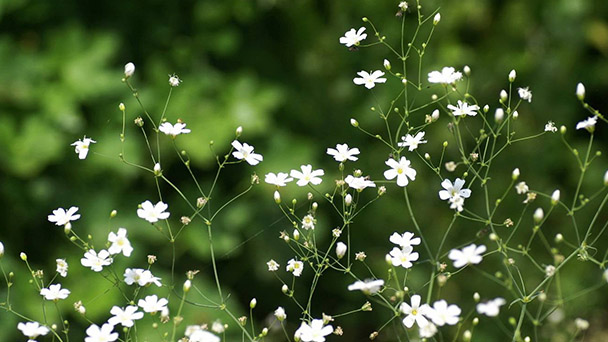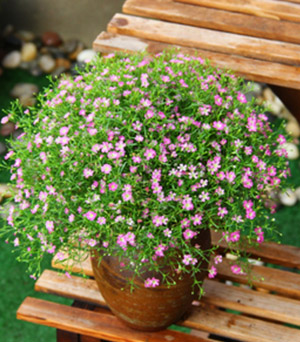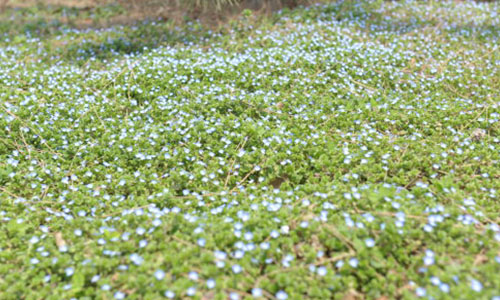The breeding methods and precautions of Gypsophila paniculata
Written by Maggie
Nov 23 2020

When breeding Gypsophila Paniculata, the soil is fluffy and slightly alkaline calcareous. There needs to be plenty of light, but shading is needed in the summer. The temperature is better to be controlled between 15 and 25 degrees, not more than 30 degrees, not less than 10 degrees. In the early stage, nitrogen fertilizer was the main fertilizer, and in the later stage, phosphorus and potash fertilizer was the main fertilizer. In addition, cannot breed it for a long time in a dark environment, so as not to affect its flowering and growth.
Gypsophila Paniculata picture

Cultivation methods of Gypsophila Paniculata:
1. Basin-soil: Due to different authigenic characteristics, each plant has different requirements on soil. Gypsophila Paniculata, on the other hand, has relatively strict requirements on soil. Gypsophila Paniculata needs to grow in soil that is slightly alkaline, well drained and breathable. This soil can be purchased from a florist or can be replaced with slightly alkaline calcareous soil.
2. Lighting: To achieve the flowering and blooming beauty of Gypsophila Paniculata, we need to pay much attention to lighting. Gypsophila Paniculata is a light-loving plant. So we can't breed them in all light except during the hot summer months. Normal light is available in all other seasons, especially during the cold winter months.
3. Temperature: Each plant has its own optimal growth temperature, and Gypsophila Paniculata's optimal growth temperature is between 15 degrees and 25 degrees. Therefore, in daily growth, the optimal growth temperature of Gypsophila Paniculata should not exceed 30 degrees, otherwise it will cause the flower deformity of Gypsophila Paniculata. The lowest temperature should not be lower than 10 degrees, otherwise Gypsophila Paniculata will stop growing.
4. Watering: Watering Gypsophila Paniculata needs to be combined with its growth cycle. When Gypsophila Paniculata is in the flowering stage, we need to reduce the frequency and amount of watering, as long as the soil is kept moist. When Gypsophila Paniculata is fully tapped, the amount of watering can be increased, but no water can be accumulated.

5. Nutrients: In order to promote the growth of Gypsophila Paniculata and prolong its flowering period, timely supply the nutrients needed in daily life. In its early stage we need fertilizer based on nitrogen, and in its later stage we can apply fertilizer based on phosphorus and potash.
Gypsophila Paniculata Planting Precautions:
Gypsophila Paniculata, although characterized by drought resistance, cold resistance and shade resistance, it does not mean that we can breed Gypsophila Paniculata in a dark environment for a long time or reduce the amount of watering. Because fo that, enough sunshine and right amount of moisture is needed, which is more conducive to its flowering and growth.

Latest Updated
- Benefits of Bugleweed - 7 Science-backed Health Benefits
- Bugleweed Dangers & Side Effects - Is It Poisonous?
- How to Plant Evergreen Trees - What You Should Know
- When to Plant Evergreens - Grow Guide for Evergreen Trees
- 12 Wonderful Evergreen Shrubs for Your Garden
- 12 Popular Evergreen Plants with Pictures for Beginners
- When And How To Prune A Lilac Bush Like a Pro
- How to Grow & Care for Lilac Vine (Hardenbergia Violacea)
- Japanese Lilac Tree (Syringa Reticulata) Care & Propagation Guide
- Shumard Oak Pros and Cons - What to Know
Popular Articles
- Winter maintenance of Antirrhinum Majus
- How to Grow Terminalia Mantaly Tree
- How to Grow and Care for Crossostephium Chinense
- How to grow Antirrhinum Majus in spring
- Peristeria Elata (Dove Orchid) Profile: Info & Care Guide
- Underwatered Snake Plant (Sansevieria Trifasciata) - Signs And How To Fix
- How to Care for Brazilian Jasmine Plant (Mandevilla Sanderi)
- How to Grow & Care for Graptopetalum Purple Delight in Summer
- Rosa Chinensis (China Rose): Plant Growing & Care Tips
- How to Care for Baby Sun Rose (Aptenia Cordifolia)